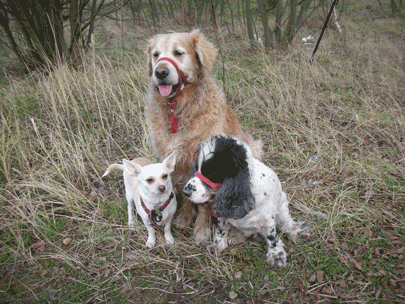The Stages of Pet Grief'
Pangs & Waves'
Whilst you may or may not experience some of the stages of pet grief, one element most people find they do experience are ‘Pangs and Waves.’
‘Pangs and Waves’ are a characteristic feature of pet grief. They are probably best described as ‘attacks of anxious pining.’ Many people find that they begin within a few hours or days following the loss of a pet and peak within 5 to 15 days.

Boo, Red and Henry
In the beginning stages of pet loss Pangs and Waves can occur frequently and spontaneously, are usually very intense, and you can find they occur very close together taking up much of your time. But as time passes they become less intense and less frequent, perhaps only occurring when you are reminded of your loss.
You may find yourself trying to ‘keep busy’ to try and forget about your grief for a while, then suddenly an object, a memory or even a smell will remind you of your pet, and you will find yourself overwhelmed and missing your pet more keenly than ever.
Typical triggers for Pangs and Waves are:
- Finding a tuft of your pet’s hair whilst tidying up.
- Finding an old toy belonging to your pet.
- Finding a forgotten photograph long thought lost in a drawer.
- Waking up and finding your pet is not beside you.
- Meeting someone you haven’t seen for a while who asks about your pet or how you are.
What do Pangs and Waves feel like?
- You may have a dry mouth.
- You may find yourself sighing deeply.
- You may have a restless but aimless feeling of hyperactivity.
- You may have difficulty concentrating and find yourself unable to focus on anything but the loss of your pet.
- You may have sudden attacks of the ‘what if’s’ and ‘if only’s’.
- You may lose interest in other people or activities that you would normally find enjoyable.
- You may have sudden feelings of helplessness and a tendency to go on hopelessly asking questions to which there are no real answers.
- You may feel a sense of panic and unease.
- You may have a feeling of ‘butterflies’ in your stomach.
- You may feel a tightness in your chest.
- You may have a fluttering feeling in your heart.
- You may find yourself bursting into tears spontaneously or even sobbing.
Often grief and especially pet grief, is perceived to be all in the mind, when in fact the symptoms felt can greatly affect the body.
It is helpful to know that the Pangs and Waves experienced as part of pet grief are actually due to a release of adrenalin from the glands situated at the top of the kidneys, and the glands are caused to do this by the very intensity of our feelings in grief.
Pangs and Waves can be very disorientating and can often make you feel as though you may be losing your mind. It may be weeks or even months since your loss, and you start to think you are over the worst stages of pet grief and feeling better, and suddenly a pang or wave engulfs you making you feel as though you are back at square one.
As C. S. Lewis wrote on the death of his wife,
`One keeps on emerging from a phase, but it always recurs. Round and round. Everything repeats. Am I going in circles, or dare I hope I am on a spiral? But if a spiral, am I going up or down it?’
Pangs and Waves can hit you when you least expect them and often for no apparent reason. Whilst most people can recognise the Pangs and Waves they experience are often due to a reminder of their loss, many are confused when the sudden onset of a pang or wave is brought on by nothing in particular, or certainly not by anything obvious.
‘Grief comes in unexpected surges…..mysterious cues that set off a reminder of grief. It comes crashing like a wave, sweeping me in it’s crest, twisting me inside out…..then it recedes.”
(Tony Talbot)
During pet grief your emotions are close to the surface and you may find yourself having Pangs and Waves as the result of seemingly unconnected things, and things that would’nt normally affect you.
For example you may be watching a TV soap and find yourself bursting into tears over a cheesy and completely unrealistic storyline or you could be watching an advert for an animal charity that you may have seen many times before, but suddenly it touches you and you find yourself bursting into tears.
This is perfectly normal; your emotions are raw and close to the surface so you are more open to sudden pangs of sadness than normal.
The crying and sobbing that occurs during Pangs and Waves can make you feel as though you are losing control and perhaps going crazy.
This is sadly a reflection on our society where openingly crying or sobbing is viewed as a sign of weakness of character or even embarrassing to people around you.
In many cultures sobbing and crying following the loss of a loved one is openly encouraged. Crying and sobbing are seen as a natural release of your powerful feelings, feelings that need to be released in order for you to work through your grief.
“Weeping is perhaps the most human and universal of relief measures.”
(Karl Menninger)
Your feelings are overwhelming and powerful and holding them in is no use to anyone, especially yourself. Do not try to be brave for yourself or others, you will probably find that at some point a pang or wave will happen when you are around other people, and they may be embarrassed by your behaviour.
But you should not be embarrassed as what you are experiencing is a perfectly natural reaction to pet grief and if you feel more comfortable, retreat to a private place where your pang or wave can be felt fully without you having to worry about other people’s opinions or judgement.
Pangs and Waves are such a common characteristic of pet grief that I have named the new Pet Loss Matters Newsletter ‘Pangs & Waves’ (or PAW for short) after them.
You can sign up for my
free 'PAW' newsletter using the form on the left hand side of this page.
Click here to learn more about the Stages of Pet Grief
Click here to learn more about typical Reactions to Pet Grief
Click here to return to the Pet Loss Matters Homepage



